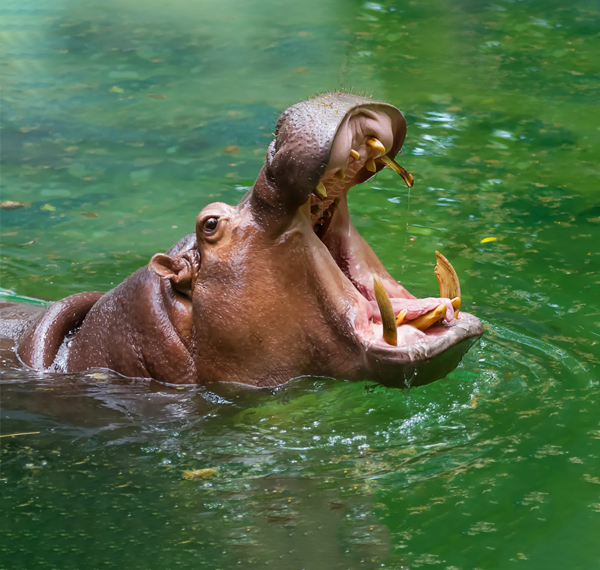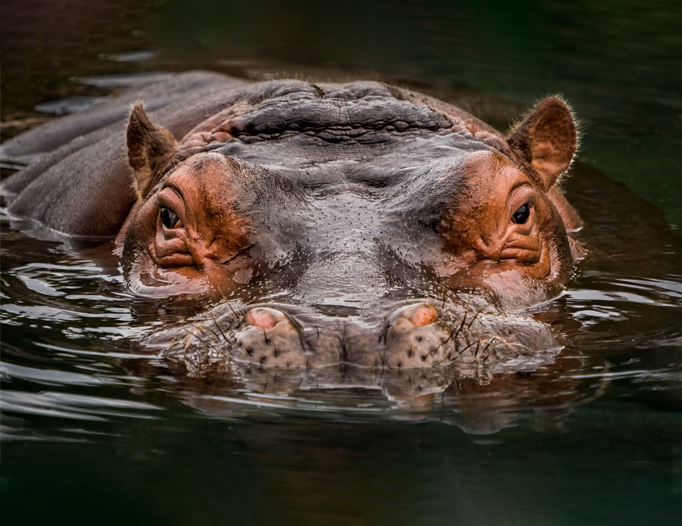Total Weight
Height
Diet
Lifespan
Total Weight
Height
Diet
Lifespan
The hippopotamus is a majestic aquatic mammal known for its massive size and powerful presence.
Found in rivers and lakes of Africa, these semi-aquatic creatures spend most of their time in water to keep
their bulky bodies cool.
With their barrel-shaped bodies, large mouths, and impressive tusks, hippos are fascinating to observe. Despite
their gentle appearance, they are considered one of the most dangerous animals in Africa.The hippopotamus is a remarkable species that commands attention and respect in the animal kingdom.
At present, Patna Zoo has four hippopotamuses: two males and two females (Bhola, Chotu, Sunita, and Basanti). The first time in 1980, Patna Zoo received hippopotamuses.
The hippopotamus is a remarkable species that commands attention and respect in the animal kingdom.


The hippo enclosure at Patna Zoo provides a spacious and natural habitat for these massive semi-aquatic animals. It features a large water
pool for swimming and cooling off, along with a grassy area for grazing and resting. The enclosure is surrounded by tall trees and bushes, recreating their natural
environment and offering shade and comfort.
There are also mud patches where hippos can roll and coat their skin for protection. A strong barrier and viewing deck ensure safety for visitors while giving them a clear view.
The enclosure is designed to meet the hippos’ behavioral and physiological needs, promoting their well-being and allowing visitors to
observe these fascinating creatures up close.
Explore Patna Zoo’s hippo habitat, where these massive creatures showcase their aquatic grace and unique behavior in natural surroundings.
Experience the wonder of these gentle giants up close, as Patna Zoo brings you closer to nature’s incredible aquatic mammals.
Hippos are herbivores, which means they primarily eat plants. Their diet mainly consists of grasses, which they graze on during nighttime feeding trips. A fully grown hippo can eat up to 40 kg of grass in a single night. Despite their massive size, hippos have a simple diet, preferring short grass found along riverbanks and floodplains.
Although they spend most of their time in the water, hippos leave the water at dusk to graze on land. Their wide mouths and strong lips help them pull up large amounts of grass quickly.
While grass makes up the majority of their diet, they have occasionally been observed eating fruits or vegetation near water bodies, but this is rare.
Hippos rely heavily on water to stay cool, but they do not feed in the water. They usually return to their resting pools before sunrise.
| Attribute | Details |
|---|---|
| Weight | Male: 1,500-1,800 kg, Female: 1,300-1,500 kg |
| Height | Approximately 5-5.5 ft at the shoulder |
| Diet | Mainly grasses, with occasional fruits and aquatic plants |
| Lifespan | 40-50 years in the wild, up to 50 years in captivity |
| Conservation Status | Vulnerable |
| Population in the Wild | Approximately 115,000-130,000 hippos left in Africa |
| Social Structure | Live in pods (groups), typically 10-30 members, led by a dominant male |
| Unique Behavior | Spend most of the day submerged in water to stay cool and graze on land at night |
| Hunting Pattern | Herbivores — primarily graze on grass for 4-5 hours a night |
| Mane Equivalent | Hairless bodies, with sparse bristles on face and tail |
| Closest Relatives | Pygmy Hippos and distant relation to whales and dolphins |
Open Now
All visits to Patna Zoo help fund our work both at the zoo and worldwide.